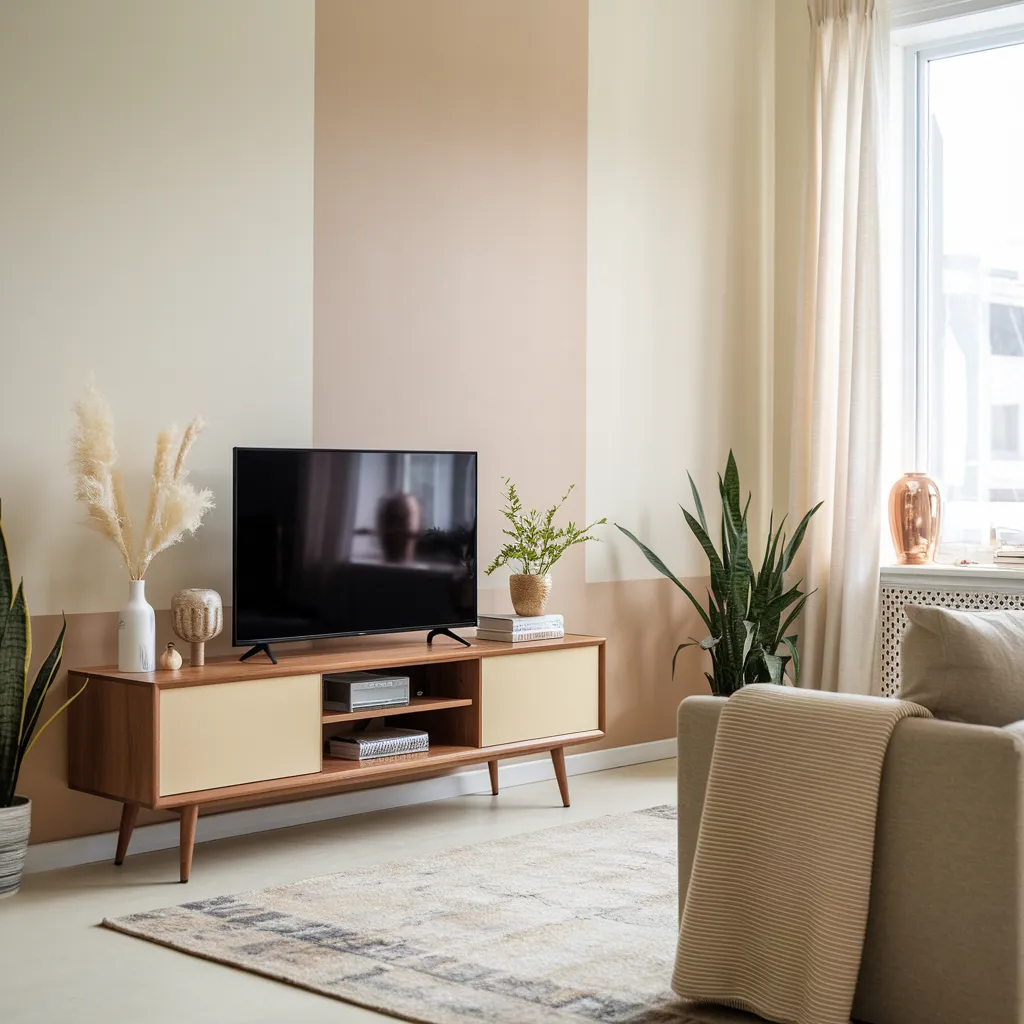TV Stands And Entertainment Units
How To Choose The Right Wooden TV Stand For Your Living Room
The right wooden TV stand supports your screen, keeps devices tidy, and sets the tone for the living space. This guide covers sizing, materials, storage, style selection, placement, cable routing, plus care tips.
Explore related articles in the TV Stands and Entertainment Units category.
Define the role of the TV zone
Start with intent. Some rooms prioritize viewing, others focus on conversation with the screen used occasionally.
Clarify what the stand must do: carry a larger panel, hide consoles, present art books, or anchor a narrow wall.
With a purpose in mind, shortlisting becomes faster and more consistent.
Browse form factors, finishes, and storage setups in our wooden TV stands collection.
Get sizing right: screen, wall, traffic flow
Screen width vs stand width
A straightforward rule: target a stand wider than the screen. Extra width improves visual balance and leaves space for speakers. For versatile living rooms, a margin of 6–12 inches on each side keeps proportions calm.
Height for comfortable viewing
When seated, the center of the screen should land near eye level. Measure seat height, subtract half the screen height, then select a stand that positions the panel in that band. Lower profiles suit lounge layouts with deep sofas. Account for door swings, windows, radiators, and walkways. If the room is compact, consider legs that lift the cabinet to create breathing space under the casework. For long walls, a low, extended silhouette supports a clean horizon line.
Material choices: solid wood vs engineered cores
Solid wood provides natural grain, repair potential, and a long service life. Minor dents can be eased, surfaces can be refinished, and aging develops character. Engineered cores reduce cost and weight but may limit refinishing options. If you expect frequent moves or heavy device loads, solid frames with quality joinery hold alignment better over time. Door and drawer faces are high-touch areas; prioritize sturdy rails, stable panels, and hardware with smooth travel. A well-sealed finish resists stains from remotes or plant watering. Avoid tops that feel springy under hand pressure.
Storage that matches real devices
List every component: streaming box, soundbar, game console, set-top receiver, media drives, even a router. Measure depth with cables attached. Shelves should exceed the deepest device by at least an inch for ventilation. If you use a soundbar, check front clearance so audio projects freely, not against a shelf lip.
- Open bays: quick access, easy airflow, simple to dust.
- Doors with soft-close: hides clutter, reduces visual noise.
- Drawers: ideal for controllers, remotes, spare cables.
- Cord ports: grommets at rear corners keep routes short.
For complementary surface pieces near the sofa or entry, see console tables, useful for lamps and drop zones.
Style selection: rustic, mid-century, minimalist
Style works best when it echoes existing architecture. Rustic pieces highlight grain, knots, and thicker profiles. Mid-century designs lean on tapered legs, frame-and-panel doors, and clean pulls. Minimalist cabinets reduce lines, using push-to-open hardware and smooth planes. Choose one anchor detail leg shape, door pattern or handle profile then keep other elements quiet so the room reads cohesive.
For styling ideas away from the screen zone, explore Console Table Inspiration or living room table choices in Coffee Table Design Tips.
Top layout tips for balanced rooms
- Center with intent: Align the stand with the sofa’s main seating span. If the fireplace dominates, offset the screen yet keep conversation sightlines open.
- Layer heights: Combine a low cabinet with tall plants or framed art so the wall gains vertical rhythm.
- Light control: Avoid direct glare from windows on the screen. Sheer curtains or a slight angle reduces reflections.
- Rug placement: The rug should sit under the front legs of seating to tie the zone together; select a pile that allows furniture to sit flat.
If the coffee table needs an update to match the new cabinet, browse coffee tables sized for common sofa depths.
Cable management that stays invisible
Plan routes before loading devices. Keep power on one side, signal lines on the other to minimize interference. Use rear cutouts that align with each shelf, not a single central hole. Short Velcro straps beat long plastic ties, since you can service one cable without undoing the bundle. Leave slack at the hinge side for doors that open wide. If you store board games, throws, or photo albums in the TV zone, consider a matched storage piece elsewhere in the room. Coordinated wood tones help the layout feel intentional even when items move between areas. For closed storage outside the media wall, review our cabinets and chests.
Finish, color, and hardware choices
Lighter oak opens smaller rooms; warm walnut adds depth; dark stains calm bright wall colors. Satin sheens resist fingerprints while maintaining grain visibility. Hardware drives personality: slim pulls suit modern rooms; recessed finger pulls deliver a quiet profile; round knobs pair well with paneled doors. If you mix metals elsewhere, repeat one tone on the cabinet for harmony.
Care tips for long service life
- Use coasters under planters or speakers to prevent rings and vibration marks.
- Dust along the grain with a soft cloth; avoid abrasive pads.
- For sticky labels on devices, apply a small amount of citrus-based remover to the label only, not the wood.
- Maintain airflow behind warm components; heat shortens finish life and strains adhesives.
Related resources for your living room project
Continue exploring: category overviews for storage in Wooden Cabinets and Chest Guides. For a broader view of the collection lineup and new arrivals, visit the homepage.

